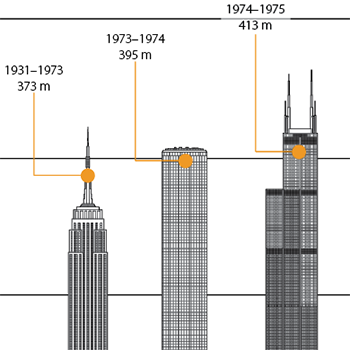Filter by
You must be a CTBUH Member to view this resource.

Canton Tower
Guangzhou TV Tower
Tower
Completed
2010
Telecommunications / Observation
Composite
604 m / 1,982 ft
37
2
6
10 m/s
114,054 m² / 1,227,667 ft²
Proposed
Construction Start
Completed
The Design Engineer is usually involved in the front end design, typically taking the leadership role in the Schematic Design and Design Development, and then a monitoring role through the CD and CA phases.
The Design Engineer is usually involved in the front end design, typically taking the leadership role in the Schematic Design and Design Development, and then a monitoring role through the CD and CA phases.
Other Consultant refers to other organizations which provided significant consultation services for a building project (e.g. wind consultants, environmental consultants, fire and life safety consultants, etc).
Material Supplier refers to organizations which supplied significant systems/materials for a building project (e.g. elevator suppliers, facade suppliers, etc).
You must be a CTBUH Member to view this resource.
Usually involved in the front end design, with a "typical" condition being that of a leadership role through either Schematic Design or Design Development, and then a monitoring role through the CD and CA phases.
Usually takes on the balance of the architectural effort not executed by the "Design Architect," typically responsible for the construction documents, conforming to local codes, etc. May often be referred to as "Executive," "Associate," or "Local" Architect, however, for consistency CTBUH uses the term "Architect of Record" exclusively.
The Design Engineer is usually involved in the front end design, typically taking the leadership role in the Schematic Design and Design Development, and then a monitoring role through the CD and CA phases.
The Design Engineer is usually involved in the front end design, typically taking the leadership role in the Schematic Design and Design Development, and then a monitoring role through the CD and CA phases.
The main contractor is the supervisory contractor of all construction work on a project, management of sub-contractors and vendors, etc. May be referred to as "Construction Manager," however, for consistency CTBUH uses the term "Main Contractor" exclusively.
Other Consultant refers to other organizations which provided significant consultation services for a building project (e.g. wind consultants, environmental consultants, fire and life safety consultants, etc).
Material Supplier refers to organizations which supplied significant systems/materials for a building project (e.g. elevator suppliers, facade suppliers, etc).
12 September 2017 - CTBUH Research
19 February 2012 - CTBUH Research

05 July 2023
Terri Meyer Boake
Height is aspirational, and having the best view from that height has become a driver in contemporary tall building design. Likewise, observation decks are a...
Located on the banks of the Pear (Zhujiang) River, Canton Tower stands across from the new main central business district of Guangzhou and creates a visual axis through the center of the city’s tallest skyscraper cluster. The axis begins in a park space to the south of the tower footprint and travels northward, crossing the river and running through the center of a large rooftop park spanning the top of a subterranean mall ringed with high-rise buildings. Continuing northward, the axis passes through additional open spaces, bisects a stadium and ends at CITIC Plaza, Guangzhou’s first supertall building, completed in 1996.
Canton Tower was constructed as a composite tube-in-tube design, featuring a reinforced concrete core containing all of the tower’s services and vertical transportation which is then set inside an outer structure made up of a steel lattice. The two structural components then frame a series of smaller structures suspended within the tower at different elevations. The smaller structures contain occupiable spaces with elliptical floor plates which rotate in orientation over the height of the tower. The rotation is then expressed to the outside of the tower through the twisting form of the steel skeletal structure, further emphasized through tapering inward to midpoint before expanding outward towards the uppermost levels. The roofs of the smaller structures within the tower have publicly accessible skygardens, allowing visitors to experience the variations of weather at different heights while serving as outdoor observation decks.
The slender form of the tower’s design makes it especially vulnerable to sway on windy days, creating the possibility for stresses on the structure and uncomfortable conditions for the occupants. As such, the design required the inclusion of a tuned mass damper system, the final compilation of which is comprised of a hybrid mass damper utilizing two 650 ton water tanks supplemented by motorized active mass dampers working in synch as the structure begins to move.
After sunset, the entire structure is illuminated in a light display of changing colors through an integrated system of LED fixtures; ensuring Canton Tower is a highly visible feature of the Guangzhou skyline during the day or night.

05 July 2023
Terri Meyer Boake
Height is aspirational, and having the best view from that height has become a driver in contemporary tall building design. Likewise, observation decks are a...

24 August 2015
CTBUH Research
Perhaps no element of a tall building is more closely related to the pure pleasure of standing high in the sky and taking in the...

01 June 2012
CTBUH Research
With the recent completion of two megatall telecommunication/observation towers it is perhaps time to review these structures and also explain why they are distinguished from...

01 February 2012
Ping Tan, Yanhui Liu & Fu Lin Zhou, Guangzhou University; Jun Teng, Harbin Institute of Technology
The paper presents an analysis of the design and application of novel Hybrid Mass Dampers for Canton Tower in Guangzhou, China. The HMD is composed...
12 September 2017
CTBUH partnered with Guinness World Records to identify the commercial building with the fastest elevator speeds and longest vertical runs.
Subscribe below to receive periodic updates from CTBUH on the latest Tall Building and Urban news and CTBUH initiatives, including our monthly newsletter. Fields with a red asterisk (*) next to them are required.
View our privacy policy